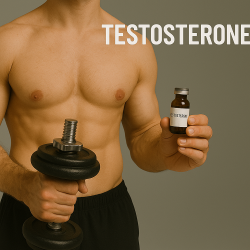 🧬 Testosterone Drug Interactions: The Overlooked Variables in Hormonal Optimization
🧬 Testosterone Drug Interactions: The Overlooked Variables in Hormonal Optimization
🔍 Introduction: Testosterone Alone Isn’t the Whole Story
Whether it’s therapeutic testosterone replacement therapy (TRT) or anabolic enhancement, testosterone is rarely taken in isolation. Most users—clinical or athletic—combine it with ancillary medications, over-the-counter supplements, or prescription drugs. However, what’s often ignored is how testosterone interacts with other substances at the enzymatic, hormonal, hepatic, and neurological level.
These drug interactions can either enhance benefits or create dangerous contradictions—ranging from hormonal imbalances and organ stress to metabolic derailment.
This guide outlines critical, often-unspoken testosterone drug interactions, so you can optimize safely and intelligently.
💉 What Is Testosterone?
Testosterone is an androgenic-anabolic steroid hormone that regulates:
-
Muscle mass
-
Libido
-
Mood and cognitive function
-
Red blood cell production
-
Bone density
-
Metabolic balance
It’s used in both TRT protocols and performance-enhancement cycles, typically via injectables (Cypionate, Enanthate, Propionate) or transdermal gels.
⚠️ Key Drug Interactions with Testosterone (Broken Down by Category)
1. 💊 Corticosteroids (e.g., Prednisone, Dexamethasone)
Interaction Risk: Antagonistic effects
-
Corticosteroids are catabolic—they break down muscle tissue.
-
They can suppress testosterone’s anabolic effects, especially during illness or injury.
-
Prolonged corticosteroid use may exacerbate HPTA suppression when paired with exogenous testosterone.
📌 Pro Tip: Avoid running high-dose corticosteroids and testosterone simultaneously unless clinically necessary. Use anabolic support (like TRT) only under supervision during corticosteroid therapy.
2. 💉 Aromatase Inhibitors (Arimidex, Letrozole, Exemestane)
Interaction Risk: Estrogen crash and receptor desensitization
While these are commonly used in testosterone cycles to prevent estrogen-related side effects (e.g., gynecomastia, water retention), overuse can backfire:
-
Severely low estrogen leads to joint pain, libido loss, cognitive dullness
-
Over-suppression can cause androgen receptor downregulation
📌 Unique Insight: Estrogen is critical for testosterone’s anabolic synergy. Low E2 = poor muscle gain, poor mood, poor libido. Target mid-range estradiol levels (20–30 pg/mL).
3. 💊 Statins (e.g., Atorvastatin, Rosuvastatin)
Interaction Risk: Lipid panel disruption + fatigue
-
Statins lower cholesterol—testosterone’s molecular building block.
-
Long-term statin use can blunt testosterone effectiveness, impair androstenedione conversion, and promote mitochondrial fatigue.
📌 Pro Insight: If you’re using testosterone and statins, monitor coenzyme Q10 levels and adjust testosterone dose accordingly. Consider supplementing with ubiquinol (active CoQ10).
4. 🔥 Stimulants (e.g., Adderall, Ephedrine, High-Dose Caffeine)
Interaction Risk: Cortisol dominance and adrenal burnout
-
Stimulants raise cortisol and dopamine, often competing with testosterone’s effects.
-
Chronic use may reduce testosterone’s positive impact on mood and blunt natural recovery post-cycle.
📌 Rare Insight: ADHD medications can mask hypogonadism symptoms by artificially boosting motivation—leading to misdiagnosed testosterone deficiency.
5. 🧪 Thyroid Hormone (e.g., T3, T4, Armour Thyroid)
Interaction Risk: Enhanced fat loss with muscle protection—or muscle loss if misused
-
When paired correctly, thyroid hormone + testosterone can create a highly anabolic-fat-burning environment.
-
Misalignment (e.g., too much T3, not enough testosterone) leads to muscle catabolism.
📌 Elite Application: In contest prep, testosterone prevents T3-induced muscle loss. In TRT, be cautious with high thyroid dosages—thyroid upregulation accelerates testosterone metabolism.
6. 💊 SSRIs / Antidepressants (e.g., Sertraline, Fluoxetine)
Interaction Risk: Suppressed libido and dopamine conflicts
-
SSRIs increase serotonin, which may counterbalance testosterone’s dopamine-enhancing effects.
-
Can result in blunted libido, even with high test levels.
📌 Clinical Note: Many patients on TRT still report low libido due to neurotransmitter misalignment, not testosterone deficiency. Evaluate SSRIs as part of a full-spectrum hormone strategy.
7. 💊 Blood Thinners (Warfarin, Aspirin, Clopidogrel)
Interaction Risk: Injection-site bleeding and hematoma risk
-
Testosterone injections may increase bleeding tendency in users on anticoagulants.
-
Risk of deep muscle bruising or hematomas post-injection.
📌 Safety Tip: Always inject slowly and use the correct gauge needle. Apply pressure post-injection and monitor for swelling or discoloration.
🧠 Advanced: Over-the-Counter Supplements That Interact
Even natural products can interfere with testosterone dynamics:
-
DHEA: May compete with exogenous testosterone or convert unpredictably
-
Ashwagandha: Can support testosterone, but overstimulation may trigger cortisol in sensitive individuals
-
Zinc and Magnesium: Essential for test metabolism, but overdosing disrupts copper levels or sleep cycles
📌 Biohacker Tip: Stack with intention—support, don’t overstimulate.
✅ Safe Practice: Testosterone Interaction Checklist
| Category | Examples | Risk Level | Notes |
|---|---|---|---|
| Corticosteroids | Prednisone, Dexamethasone | High | Opposes anabolic effect |
| AI’s | Arimidex, Aromasin | Medium | Overuse = estrogen crash |
| Statins | Atorvastatin, Simvastatin | Medium | Watch cholesterol + CoQ10 |
| Stimulants | Adderall, DMAA | Medium | Cortisol and adrenal stress |
| Thyroid Hormones | T3, T4 | Medium | Too much = catabolism |
| SSRIs | Zoloft, Prozac | Medium | Libido + dopamine interaction |
| Anticoagulants | Warfarin, Aspirin | Low–Medium | Injection site risk |
| OTC Supplements | DHEA, Zinc, Ashwagandha | Low | Can support or disrupt test balance |
🧠 Final Thoughts: Don’t Just Dose—Diagnose Interactions
Testosterone therapy isn’t plug-and-play—it’s a dynamic, interconnected hormonal system. Every drug or supplement you add creates chemical dialogue with testosterone, influencing how it behaves, metabolizes, and manifests in your body.